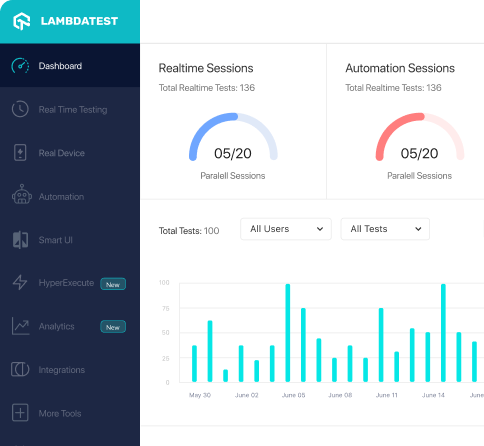How to use AbstractFloatAssert class of org.assertj.core.api package
Best Assertj code snippet using org.assertj.core.api.AbstractFloatAssert
Source: FluentWmAssert.java
...3import java.util.Date;4import org.assertj.core.api.AbstractBooleanAssert;5import org.assertj.core.api.AbstractDateAssert;6import org.assertj.core.api.AbstractDoubleAssert;7import org.assertj.core.api.AbstractFloatAssert;8import org.assertj.core.api.AbstractIntegerAssert;9import org.assertj.core.api.AbstractLongAssert;10import org.assertj.core.api.AbstractObjectAssert;11import org.assertj.core.api.AbstractStringAssert;12import org.assertj.core.api.Condition;13import org.assertj.core.api.Descriptable;14import org.assertj.core.api.ObjectArrayAssert;15import org.assertj.core.error.BasicErrorMessageFactory;16import org.assertj.core.error.ErrorMessageFactory;17import org.assertj.core.error.ShouldBeInstance;18import com.wm.data.IData;19//public class FluentWmAssert extends AbstractAssert<FluentWmAssert, Object> {20public class FluentWmAssert extends AbstractObjectAssert<FluentWmAssert, Object> {21 public static class ShouldBeLikeType extends BasicErrorMessageFactory {22 private ShouldBeLikeType(Object actual, String likeWhat) {23 super("%nExpecting:%n <%s>%nto be like " + likeWhat + "%n", actual);24 }25 public static ErrorMessageFactory shouldBeLike(Object actual, String likeWhat) {26 return new ShouldBeLikeType(actual, likeWhat);27 }28 }29 public static enum Type {30 Boolean(Boolean.class, "true|false"),31 Integer(Integer.class, "-?\\d+"),32 Long(Long.class, "-?\\d+"),33 Float(Float.class, "(+|-)?\\d*(\\.\\d*)?"),34 Double(Double.class, "(+|-)?\\d*(\\.\\d*)?"),35 Date(Date.class, ".*"); //FIXME36 public final Class<?> type;37 public final String expression;38 private Type(Class<?> type, String expression) {39 this.type = type;40 this.expression = expression;41 }42 }43 44 45 //some helpful conditions46 47 public static final Condition<Object> IS_NULL = new Condition<>(m -> m == null, "isNull");48 public static final Condition<Object> IS_EMPTY = new Condition<>(m -> "".equals(m), "isEmpty");49 50 protected final String string;51 protected final boolean isString;52 public FluentWmAssert(Object actual) {53 super(actual, FluentWmAssert.class);54 isString = actual instanceof String;55 string = isString ? (String) actual : null;56 }57 @SuppressWarnings("unchecked")58 private <T extends Descriptable<?>> T describe(T assertion) {59 return (T) assertion.as(info.description());60 }61 62 private boolean checkString(Type type) {63 if (isString) {64 if (!string.matches(type.expression))65 failWithMessage(ShouldBeLikeType.shouldBeLike(actual, type.type.getSimpleName()).create());66 } else {67 if(actual != null)68 isInstanceOf(type.type);69 }70 return isString;71 }72 73 private Object forceType(Type type) {74 //is there a way to cast based on a type stored in enum?! I guess not, but at least this is chainable75 return forceType(type.type);76 }77 78 private Object forceType(Class<?> type) {79 if(actual != null)80 isInstanceOf(type);81 return actual;82 }83 84 // utils85 86 public FluentWmAssert dump() {87 System.out.println("== FluentWmAssert =============================================");88 System.out.println("class(actual): " + (actual == null ? "null" : actual.getClass().getCanonicalName()));89 System.out.println("---------------------------------------------------------------");90 System.out.println(actual);91 System.out.println("===============================================================");92 return this;93 }94 95 public FluentWmAssert isNullOrEmpty() {96 return is(anyOf(IS_NULL, IS_EMPTY));97 }98 99 public FluentWmAssert isNotNullOrEmpty() {100 return is(not(anyOf(IS_NULL, IS_EMPTY)));101 }102 103 104 // type assuming105 public AbstractStringAssert<?> isString() {106 isNotNull();107 isInstanceOf(String.class);108 return describe(assertThat((String) actual));109 }110 public AbstractBooleanAssert<?> isBoolean() {111 return describe(assertThat((Boolean) forceType(Type.Boolean)));112 }113 public AbstractBooleanAssert<?> asBoolean() {114 return describe(assertThat(checkString(Type.Boolean) ? Boolean.parseBoolean(string) : (Boolean) actual));115 }116 117 public AbstractBooleanAssert<?> asBool() {118 return asBoolean();119 }120 121 public AbstractIntegerAssert<?> isInteger() {122 return describe(assertThat((Integer) forceType(Type.Integer)));123 }124 public AbstractIntegerAssert<?> asInteger() {125 return describe(assertThat(checkString(Type.Integer) ? Integer.parseInt(string, 10) : (Integer) actual));126 }127 128 public AbstractIntegerAssert<?> asInt() {129 return asInteger();130 }131 public AbstractLongAssert<?> isLong() {132 return describe(assertThat((Long) forceType(Type.Long)));133 }134 public AbstractLongAssert<?> asLong() {135 return describe(assertThat(checkString(Type.Long) ? Integer.parseInt(string, 10) : (Long) actual));136 }137 138 public AbstractFloatAssert<?> isFloat() {139 return describe(assertThat((Float) forceType(Type.Float)));140 }141 142 public AbstractFloatAssert<?> asFloat() {143 return describe(assertThat(checkString(Type.Float) ? Float.parseFloat(string) : (Float) actual));144 }145 146 public AbstractDoubleAssert<?> isDouble() {147 return describe(assertThat((Double) forceType(Type.Double)));148 }149 150 public AbstractDoubleAssert<?> asDouble() {151 return describe(assertThat(checkString(Type.Double) ? Float.parseFloat(string) : (Double) actual));152 }153 154 public AbstractDateAssert<?> isDate() {155 return describe(assertThat((Date) forceType(Type.Date)));156 }...Source: ValueAssert.java
...5import org.assertj.core.api.AbstractAssert;6import org.assertj.core.api.AbstractBooleanAssert;7import org.assertj.core.api.AbstractByteAssert;8import org.assertj.core.api.AbstractDoubleAssert;9import org.assertj.core.api.AbstractFloatAssert;10import org.assertj.core.api.AbstractIntegerAssert;11import org.assertj.core.api.AbstractLocalDateAssert;12import org.assertj.core.api.AbstractLocalTimeAssert;13import org.assertj.core.api.AbstractStringAssert;14import org.assertj.core.api.AbstractThrowableAssert;15import org.assertj.core.api.ObjectArrayAssert;16import org.graalvm.polyglot.Value;17import static org.assertj.core.api.Assertions.assertThat;18/**19 * Assertion methods for a {@link Value} assuming the {@link Value} represents polyglot (any) guest language.20 * <p>21 * To create an instance of this class, invoke22 * <code>23 * {@link ValueAssertions ValueAssertions}{@link ValueAssertions#assertThat(Value) .assertThat(value)}24 * </code>25 * </p>26 *27 * @see AbstractAssert28 */29public class ValueAssert extends AbstractAssert<ValueAssert, Value> {30 public ValueAssert(Value value) {31 super(value, ValueAssert.class);32 }33 public AbstractStringAssert<?> isStringThat() {34 validateValueType(String.class, Value::isString);35 return assertThat(actual.asString());36 }37 public AbstractBooleanAssert<?> isBooleanThat() {38 validateValueType(Boolean.class, Value::isBoolean);39 return assertThat(actual.asBoolean());40 }41 @SuppressWarnings({"UnusedReturnValue"})42 public AbstractThrowableAssert<?, ? extends Throwable> isThrowableThat() {43 validateValueType(Throwable.class, Value::isException);44 return assertThat(actual.as(Throwable.class));45 }46 public AbstractDoubleAssert<?> isDoubleThat() {47 validateValueType(Double.TYPE, Value::fitsInDouble);48 return assertThat(actual.asDouble());49 }50 public AbstractIntegerAssert<?> isIntegerThat() {51 validateValueType(Integer.TYPE, Value::fitsInInt);52 return assertThat(actual.asInt());53 }54 public AbstractByteAssert<?> isByteThat() {55 validateValueType(Byte.TYPE, Value::fitsInByte);56 return assertThat(actual.asByte());57 }58 public AbstractFloatAssert<?> isFloatThat() {59 validateValueType(Float.TYPE, Value::fitsInFloat);60 return assertThat(actual.asFloat());61 }62 public AbstractLocalDateAssert<?> isLocalDateThat() {63 validateValueType(LocalDate.class, Value::isDate);64 return assertThat(actual.asDate());65 }66 public AbstractLocalTimeAssert<?> isLocalTimeThat() {67 validateValueType(LocalTime.class, Value::isTime);68 return assertThat(actual.asTime());69 }70 public ObjectArrayAssert<Value> isArrayThat() {71 validateValueType(Value[].class, Value::hasArrayElements);72 Value[] values = new Value[Long.valueOf(actual.getArraySize()).intValue()];...Source: FloatAssert.java
1package io.github.derkrischan.pdftest;2import org.apache.pdfbox.pdmodel.PDDocument;3import org.assertj.core.api.AbstractFloatAssert;4import edu.umd.cs.findbugs.annotations.SuppressFBWarnings;5/**6 * Intermediate FloatAssert class works as a bridge between AssertJ's{@link AbstractFloatAssert} and 7 * {@link FluentPdfAsserter}.8 * The class is package private because the main entry point for PDF verifications should be {@link PdfAssertions}.9 * 10 * @author krischan11 *12 */13public class FloatAssert extends AbstractFloatAssert<FloatAssert> implements FluentPdfAsserter {14 /** the PDF document under test */15 private PDDocument pdfUnderTest;16 17 /**18 * Package private constructor for {@link FloatAssert} to prevent public usage.19 * 20 * @param pDate the float value under test21 * @param pPdf the PDF document under test22 */23 @SuppressFBWarnings("CD_CIRCULAR_DEPENDENCY")24 FloatAssert(final Float pActualFloat, final PDDocument pPdf) {25 super(pActualFloat, FloatAssert.class);26 pdfUnderTest = pPdf;27 }...AbstractFloatAssert
Using AI Code Generation
1import org.assertj.core.api.AbstractFloatAssert;2import org.assertj.core.api.Assertions;3public class 1 {4 public static void main(String[] args) {5 AbstractFloatAssert<?> abstractFloatAssert = Assertions.assertThat(1.0f);6 abstractFloatAssert.isBetween(0.5f, 1.5f);7 abstractFloatAssert.isCloseTo(1.0f, Assertions.withinPercentage(10));8 }9}10 AbstractFloatAssert<?> abstractFloatAssert = Assertions.assertThat(1.0f);11 abstractFloatAssert.isBetween(0.5f, 1.5f);12 symbol: method isBetween(float,float)AbstractFloatAssert
Using AI Code Generation
1import org.assertj.core.api.AbstractFloatAssert;2import org.assertj.core.api.AbstractAssert;3import org.assertj.core.api.AbstractObjectAssert;4import org.assertj.core.api.Assertions;5import org.assertj.core.api.ObjectAssert;6import org.assertj.core.api.ObjectAssertBaseTest;7import org.assertj.core.api.ObjectAssertFactory;8import org.assertj.core.api.ObjectAssertTest;9import org.assertj.core.api.ObjectAssert_Test;10import org.assertj.core.api.ObjectArrayAssert;11import org.assertj.core.api.ObjectArrayAssertBaseTest;12import org.assertj.core.api.ObjectArrayAssert_Test;13import org.assertj.core.api.ObjectEnumerableAssert;14import org.assertj.core.api.ObjectEnumerableAssertBaseTest;15import org.assertj.core.api.ObjectEnumerableAssert_Test;16import org.assertj.core.api.ObjectGroupAssert;17import org.assertj.core.api.ObjectGroupAssertBaseTest;18import org.assertj.core.api.ObjectGroupAssert_Test;19import org.assertj.core.api.ObjectGroupAssert_factory;20import org.assertj.core.api.ObjectGroupAssert_with_Groups_Test;21import org.assertj.core.api.ObjectGroupAssert_with_Tuple_Test;22import org.assertj.core.api.ObjectGroupAssert_with_Tuple_Test_Tuple;23import org.assertj.core.api.ObjectGroupAssert_with_Tuple_Test_Tuple_Test;24import org.assertj.core.api.ObjectGroupAssert_with_Tuple_Test_Tuple_Test_Tuple;25import org.assertj.core.api.ObjectGroupAssert_with_Tuple_Test_Tuple_Test_Tuple_Test;26import org.assertj.core.api.ObjectGroupAssert_with_Tuple_Test_Tuple_Test_Tuple_Test_Tuple;27import org.assertj.core.api.ObjectGroupAssert_with_Tuple_Test_Tuple_Test_Tuple_Test_Tuple_Test;28import org.assertj.core.api.ObjectGroupAssert_with_Tuple_Test_Tuple_Test_Tuple_Test_Tuple_Test_Tuple;29import org.assertj.core.api.ObjectGroupAssert_with_Tuple_Test_Tuple_Test_Tuple_Test_Tuple_Test_Tuple_Test;30import org.assertj.core.api.ObjectGroupAssert_with_Tuple_Test_Tuple_Test_Tuple_Test_Tuple_Test_Tuple_Test_Tuple;31import org.assertj.core.api.ObjectGroupAssert_with_Tuple_Test_Tuple_Test_Tuple_Test_Tuple_Test_Tuple_Test_Tuple_Test;32import org.assertj.core.api.ObjectGroupAssert_with_Tuple_Test_Tuple_Test_Tuple_Test_Tuple_Test_Tuple_Test_Tuple_Test_Tuple;33import org.assertj.core.api.ObjectGroupAssert_with_Tuple_Test_Tuple_Test_Tuple_Test_Tuple_Test_Tuple_Test_Tuple_Test_Tuple_Test;34import org.assertj.core.api.ObjectGroupAssert_with_Tuple_Test_Tuple_Test_Tuple_TestAbstractFloatAssert
Using AI Code Generation
1import org.assertj.core.api.AbstractFloatAssert;2import org.assertj.core.api.Assertions;3public class 1 {4 public static void main(String[] args) {5 AbstractFloatAssert<?> abstractFloatAssert = Assertions.assertThat(0.0f);6 System.out.println(abstractFloatAssert);7 }8}AbstractFloatAssert
Using AI Code Generation
1import org.assertj.core.api.AbstractFloatAssert;2public class AbstractFloatAssertExample {3 public static void main(String[] args) {4 AbstractFloatAssert abstractFloatAssert = new AbstractFloatAssert(1.0f) {5 public AbstractFloatAssert isEqualTo(float expected) {6 return null;7 }8 };9 abstractFloatAssert.isEqualTo(2.0f);10 }11}12 at org.assertj.core.api.AbstractFloatAssert.isEqualTo(AbstractFloatAssert.java:64)13 at AbstractFloatAssertExample.main(AbstractFloatAssertExample.java:14)AbstractFloatAssert
Using AI Code Generation
1import org.assertj.core.api.AbstractFloatAssert;2import org.assertj.core.api.Assertions;3public class AbstractFloatAssertClass {4 public static void main(String[] args) {5 AbstractFloatAssert abstractFloatAssert = Assertions.assertThat(10.0f);6 abstractFloatAssert.isEqualTo(10.0f);7 }8}AbstractFloatAssert
Using AI Code Generation
1import org.assertj.core.api.AbstractFloatAssert;2public class AssertJAssertFloat {3 public static void main(String[] args) {4 AbstractFloatAssert<?> abstractFloatAssert = new AbstractFloatAssert<>(1.0f) {5 public AbstractFloatAssert<?> isEqualTo(Object o) {6 return null;7 }8 };9 abstractFloatAssert.isZero();10 }11}AbstractFloatAssert
Using AI Code Generation
1package org.example;2import static org.assertj.core.api.Assertions.assertThat;3public class App {4 public static void main(String[] args) {5 assertThat(1.0f).as("1.0f").isEqualTo(1.0f);6 }7}8package org.example;9import static org.assertj.core.api.Assertions.assertThat;10public class App {11 public static void main(String[] args) {12 assertThat(1.0d).as("1.0d").isEqualTo(1.0d);13 }14}15package org.example;16import static org.assertj.core.api.Assertions.assertThat;17public class App {18 public static void main(String[] args) {19 assertThat(1L).as("1L").isEqualTo(1L);20 }21}22package org.example;23import static org.assertj.core.api.Assertions.assertThat;24public class App {25 public static void main(String[] args) {26 assertThat(1).as("1").isEqualTo(1);27 }28}29package org.example;30import static org.assertj.core.api.Assertions.assertThat;31public class App {32 public static void main(String[] args) {33 assertThat((short) 1).as("(short) 1").isEqualTo((short) 1);34 }35}36package org.example;37import static org.assertj.core.api.Assertions.assertThat;38public class App {39 public static void main(String[] args) {40 assertThat('1').as("'1'").isEqualTo('1');41 }42}43package org.example;44import static org.assertj.core.api.Assertions.assertThat;45public class App {46 public static void main(String[] args) {47 assertThat((byte) 1).as("(byte) 1").isEqualTo((byte) 1);48 }49}AbstractFloatAssert
Using AI Code Generation
1package org.example;2import org.assertj.core.api.AbstractFloatAssert;3import org.junit.jupiter.api.Test;4public class AppTest {5 public void testAssertJ() {6 AbstractFloatAssert<?> abstractFloatAssert;7 }8}AbstractFloatAssert
Using AI Code Generation
1import static org.assertj.core.api.Assertions.*;2import org.assertj.core.api.AbstractFloatAssert;3import org.assertj.core.api.AbstractAssert;4public class 1{5 public static void main(String[] args){6 float f1 = 1.2f;7 float f2 = 2.5f;8 assertThat(f1).isBetween(f2, f1);9 }10}11The assertThat(f1) is used to create an instance of AbstractAbstractFloatAssert
Using AI Code Generation
1import static org.assertj.core.api.Assertions.*;2import org.assertj.core.api.AbstractFloatAssert;3public class AssertJFloatAssertTest {4 public static void main(String[] args) {5 float actual = 5.5f;6 AbstractFloatAssert<?> abstractFloatAssert = assertThat(actual);7 abstractFloatAssert.isBetween(5f, 6f);8 abstractFloatAssert.isGreaterThan(5f);9 abstractFloatAssert.isLessThan(6f);10 }11}12BUILD SUCCESSFUL (total time: 0 seconds)Blogs
Check out the latest blogs from LambdaTest on this topic:
Most test automation tools just do test execution automation. Without test design involved in the whole test automation process, the test cases remain ad hoc and detect only simple bugs. This solution is just automation without real testing. In addition, test execution automation is very inefficient.
In my last blog, I investigated both the stateless and the stateful class of model-based testing. Both have some advantages and disadvantages. You can use them for different types of systems, depending on whether a stateful solution is required or a stateless one is enough. However, a better solution is to use an aggregate technique that is appropriate for each system. Currently, the only aggregate solution is action-state testing, introduced in the book Paradigm Shift in Software Testing. This method is implemented in Harmony.
One of the most important tasks of a software developer is not just writing code fast; it is the ability to find what causes errors and bugs whenever you encounter one and the ability to solve them quickly.
Websites and web apps are growing in number day by day, and so are the expectations of people for a pleasant web experience. Even though the World Wide Web (WWW) was invented only in 1989 (32 years back), this technology has revolutionized the world we know back then. The best part is that it has made life easier for us. You no longer have to stand in long queues to pay your bills. You can get that done within a few minutes by visiting their website, web app, or mobile app.
Automation Testing Tutorials
Learn to execute automation testing from scratch with LambdaTest Learning Hub. Right from setting up the prerequisites to run your first automation test, to following best practices and diving deeper into advanced test scenarios. LambdaTest Learning Hubs compile a list of step-by-step guides to help you be proficient with different test automation frameworks i.e. Selenium, Cypress, TestNG etc.
LambdaTest Learning Hubs:
- JUnit Tutorial
- TestNG Tutorial
- Webdriver Tutorial
- WebDriverIO Tutorial
- Protractor Tutorial
- Selenium 4 Tutorial
- Jenkins Tutorial
- NUnit Tutorial
- Jest Tutorial
- Playwright Tutorial
- Cypress Tutorial
- PyTest Tutorial
YouTube
You could also refer to video tutorials over LambdaTest YouTube channel to get step by step demonstration from industry experts.
Most used methods in AbstractFloatAssert
- AbstractFloatAssert
- isNaN
- isNotNaN
- isZero
- assertIsPrimitiveZero
- assertIsPrimitiveNonZero
- isNotZero
- isOne
- isPositive
- isNegative
- isNotNegative
- isNotPositive
- isEqualTo
- isCloseTo
- isNotCloseTo
- isNotEqualTo
- isLessThan
- isLessThanOrEqualTo
- isGreaterThan
- isGreaterThanOrEqualTo
- isBetween
- isStrictlyBetween
- usingComparator
- usingDefaultComparator
- noCustomComparatorSet
- isFinite
- isNotFinite
- isInfinite
- isNotInfinite
Try LambdaTest Now !!
Get 100 minutes of automation test minutes FREE!!



